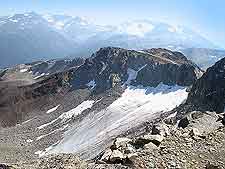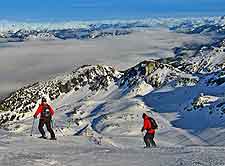Whistler History Facts and Timeline
(Whistler, British Columbia, Canada)

Even though Whistler was technically developed in the 1960s, this beautiful area of British Columbia was inhabited by local indigenous tribes, known as the Lil'wat and the Squamish peoples, many centuries prior to British settlement. Indeed, the stunning Whistler Valley was a common trading route between the two First Nations tribes.
First Nations
The Squamish culture was the first and most influential indigenous culture to reside in the area which is now known as Whistler. The Lil'wat people traded with the Squamish villages throughout the local valley region. Unfortunately, with the arrival of the British, many of the local tribes were moved from the area and populations diminished. Nevertheless, the culture of the local indigenous tribes can still be experienced today at the local Squamish Lil'wat Culture Center, which boasts an incredible display of live performances and exhibits.
The 1860s saw the first European settlers arrive in the area. The Royal British Navy surveyed the region and named it London Mountain due to the thick fog that often blanketed it, reminding them of the British capital. However, the name 'Whistler' was later adopted after the call of the local marmots (ground squirrels).
The area became popular with prospectors and hunters, but it wasn't until 1914 that Myrtle and Alex Phillip developed Rainbow Lodge, next to Alta Lake, as lodging for visitors arriving for fishing, boating, hiking and other summer activities. The lodge gained popularity as a resort municipality after the Pacific Great Eastern Railway connected
Vancouver and Whistler in 1914. Even though summer tourism was the greatest economic influence in the town, the early 20th century also saw the growth of the logging industry in Whistler.

Logging and Tourism Industry
Prior to the development of Whistler in the 1960s, it was simply a small logging and summer resort that primarily lured hikers, boaters, fishermen, hunters, trappers and loggers. Rainbow Lodge was the main accommodation, and even though it burnt down in 1977, Rainbow Park still exists today.
Skiing was not part of the local appeal. The area was short on infrastructure, sewage systems, electricity and supplies, not to mention the difficulty in getting to the town. However, this all changed with the arrival of businessman Franz Wilhelmsen and his business associates' dreams of hosting the Winter Olympics. This aspect of the town's history can be explored today in the Whistler Museum and Archives Center, located in the heart of the city.
It was during the 1960s that Whistler really transformed into a major resort town. In 1962, four wealthy businessmen recognised the area's tourism potential while visiting and began to develop Whistler into a world-class ski resort. The initial goal was to expand the town to host the 1968 Winter Olympics, so they established the Garibaldi Lift Company, and with that, the Whistler Ski Resort officially opened for business. It has since grown to be among the top ski resorts on the planet.
Additionally, the mining and fur trade has been big business throughout much of Whistler's history. Mining shafts can be explored along the Singing Pass Trail near the town.

Olympics Dreams
Whistler grew on the back of Franz Wilhelmsen and several of his associates in the 1960s, as they developed the resort into a skiing wonderland - one they hoped would eventually host the 1968 Winter Olympics. But Denver, Colorado ended up winning the Olympics bid. Nevertheless, a magnificent ski resort developed as a result and Whistler continued to grow throughout both summer and winter seasons.
When it materialised that
Denver couldn't meet its obligation, Whistler was offered the chance to host, but actually turned it down due to lack of notice and
Innsbruck became the eventual host. The resort's Olympic dream finally held true when the 2010 Winter Olympics were jointly hosted by Vancouver and Whistler. Nowadays it is equally famous for its summer activities, most notably mountain biking.
 Even though Whistler was technically developed in the 1960s, this beautiful area of British Columbia was inhabited by local indigenous tribes, known as the Lil'wat and the Squamish peoples, many centuries prior to British settlement. Indeed, the stunning Whistler Valley was a common trading route between the two First Nations tribes.
Even though Whistler was technically developed in the 1960s, this beautiful area of British Columbia was inhabited by local indigenous tribes, known as the Lil'wat and the Squamish peoples, many centuries prior to British settlement. Indeed, the stunning Whistler Valley was a common trading route between the two First Nations tribes.
